“Speaking of computing power, we must think about what value it can bring us, and how to make AI infrastructure exert better application capabilities. ” Said Yang Fan, Co-founder of SenseTime and President of SenseCore Business Group at the 2022 China Computational Power Conference.
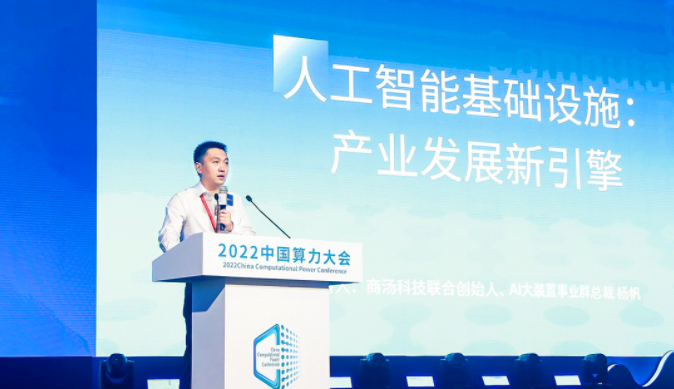
On July 30, the 2022 China Computational Power Conference was held. Yang Fan, Co-founder of SenseTime and President of SenseCore Business Group, Ling Wen, Vice Governor of Shandong Province, and several academicians of the Chinese Academy of Engineering including Guo Guirong and Liu Yunjie, as well as many industry leaders and experts from Huawei, Ant Group, National Supercomputing Center in Jinan, etc. attended the main forum of the Conference and delivered a keynote speech themed by "AI Infrastructure: A New Engine for Industrial Development”.
At the Conference, “2022 Outstanding Computing Power Empowerment Cases in China” were released, and SenseTime's AIDC was honorably listed.
This article summarized the content of Yang Fan's speech.
AI — a Vital Tool for Scientific Breakthroughs
In the last 30 to 50 years of human development, although the information industry and information technology have maintained rapid development, there have been relatively few breakthroughs in basic science.
If this trend continues, a scramble for stock resources will happen across the world, which will bring huge challenges.
For a long time, there have been two cognitive paradigms in the world of human cognition: induction, i.e., summarization based on phenomena; and deduction, i.e., inference based on formulas.
In recent years, we have used computers to process big data and make simulations by analogy with induction and inference, and we may call it the third or fourth paradigm.
However, putting aside the general cognition and looking back at the scientific and technological progress in human history, we will find that many major epoch-making breakthroughs actually come from accidental events, such as the General Theory of Relativity and Newton's First Law of Motion — we call them “the conjectures of genius”.
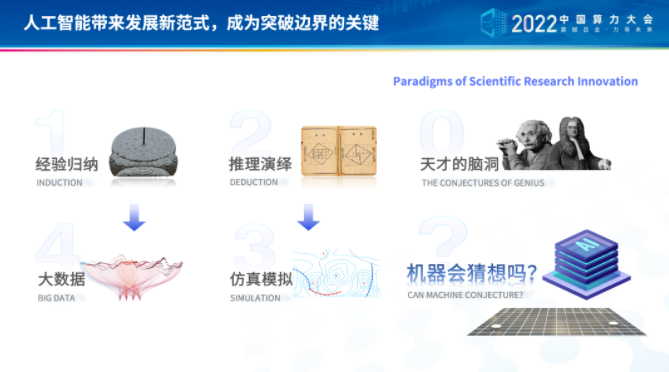
Think about it — if a machine can make similar conjectures, it can help us promote the progress of the entire scientific system. In fact, in the past two years, the industry has begun to use artificial intelligence to drive the progress of science and technology in various fields and disciplines, and has made very significant breakthroughs.
In the future, artificial intelligence may become a vital tool to help human beings break through the cognitive barriers or boundaries of scientific and technological progress.
This kind of tool has a huge demand for computing power at a very fast growth rate. It is reported that every three to four months, the demand of the most complex AI models in the industry for computing power will double, and in the past six years, it has increased by hundreds of thousands of times.
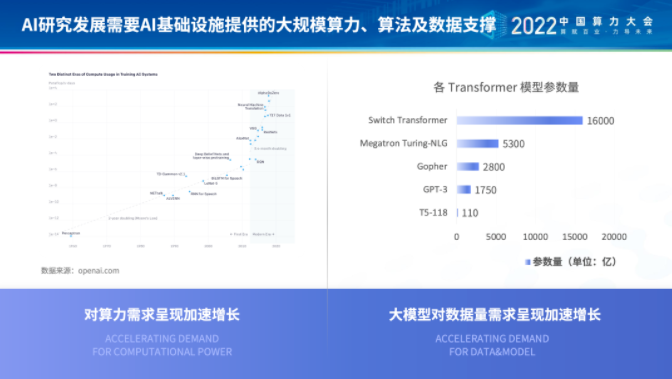
The “AI foundation model”, an important tool and means to promote the improvement of AI capabilities today, also shows an extremely high non-linear growth in the number of parameters, which also requires ultra-large-scale computing power support.
Trinity of Computing Power, Algorithms, and Data
In the past two years, many international technology giants have spent huge sums of money to build AIDCs, such as Facebook and Tesla; and many governmental agencies, enterprises, and platform companies in China are also building new-generation AI infrastructure to plan for marching into frontier fields such as intelligent driving and metaverse.
How should we understand AI infrastructure? From the perspective of the three fundamental elements of AI, computing power is productivity, algorithms are production relations, and data are production materials. However, computing power and its final application and value as well as the resources and data it needs to consume are actually inseparable and constitute a trinity.
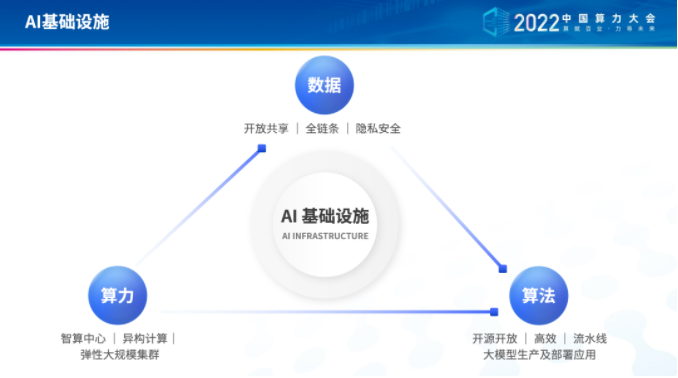
In terms of computing power, if the built computing power cannot be effectively used, or cannot generate value after use or bring technical progress and better changes to the society, it is meaningless and ineffective.
Speaking of computing power, we must think about what value it can bring us, and how to make AI infrastructure exert better application capabilities.
In fact, computing power still has many pain points today, including not limited to heterogeneous computing of a large number of domestic chips, large-scale utilization of big data, foundation models, and big algorithms for the elasticity of clusters.
In terms of algorithms, with the in-depth development of artificial intelligence, a big challenge will arise: the cost for AI to solve a problem nowadays may be greater than the benefits it brings.
If you need to use more expensive means to solve the problem, it will be difficult to achieve true commercialization in the end, and also difficult to bring huge value to the industry.
We also need to solve the problem of how to reduce the cost of algorithm production exponentially, so as to achieve higher production efficiency, shorter production time, and less dependence on data.
At the data level, the problem of data island still exists in many industries. Many of the data of enterprises and organizations are one-sided and incomplete. How can these data be brought together to play a role and achieve a balance in terms of user privacy and security protection?
As a means of production, data is more complex than traditional means of production such as land and oil, and its forms are also very diverse. How can we make it capable of forming a full chain?
Facing the above-mentioned problems, SenseCore provides the solution — SenseCore.

This solution may not be perfect, and many industry peers are still continuing to explore different solutions, but everyone is walking on a common path.
Ultimately, the key to AI infrastructure lies in how to use new technologies, new means, and new mechanisms to solve the problems in the further development of the AI industry.
Streamline the Closed Loop from Computing Power Innovation to Industrial Value
The Artificial Intelligence Data Center (AIDC) built by SenseTime started operation this year, which has a peak computing power of 3740P and is currently one of the largest AI data centers in Asia. At present, AI data centers in many regions only have a scale of 100Pat the beginning and 300~1000P in the long-term plan.
Such a huge advantage comes from SenseTime's accumulation of rich experience in the industry in the past.
The future AI industry will have a great demand and space for computing power, data, and algorithms. And the most important thing is to figure out what kind of value can we create for users and customers in various industries when we have better AI infrastructure.
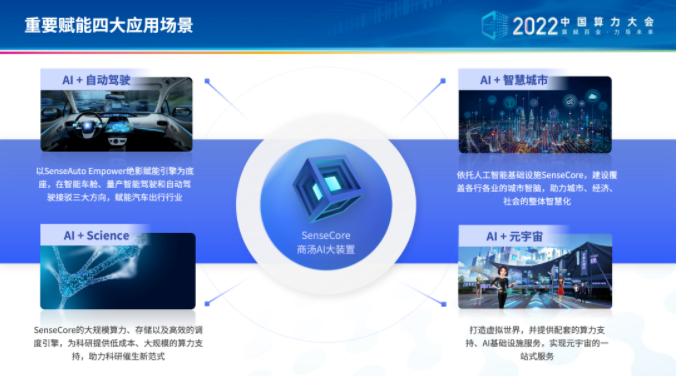
Taking Smart City as an example, the entire city-level services and comprehensive management can be completed more automatically through a large amount of video processing and analysis now, but this requires better AI infrastructure and computing power.
In the fields of intelligent driving, Internet of Vehicles, and intelligent transportation, the entire industry also continues to put forward high standards and requirements for AI infrastructure and the application of computing power.
In the field of scientific research, SenseTime AIDC is working with the National Center for Protein Science (Shanghai) and universities in Shandong to continuously advance the integration of vocational education with the industry, and use AI to help promote and improve technology.
In the fields of AR and VR, the consumption of computing power is also very large. How to use computing power to bring new experiences to our daily life, offline commercial retail, consumer entertainment, etc. is the direction of SenseTime's exploration.
The AIDC has also implemented many industrial applications in Shandong, including smart park, intelligent remote sensing, smart healthcare, smart education, etc., to cultivate and expand the artificial intelligence industry.
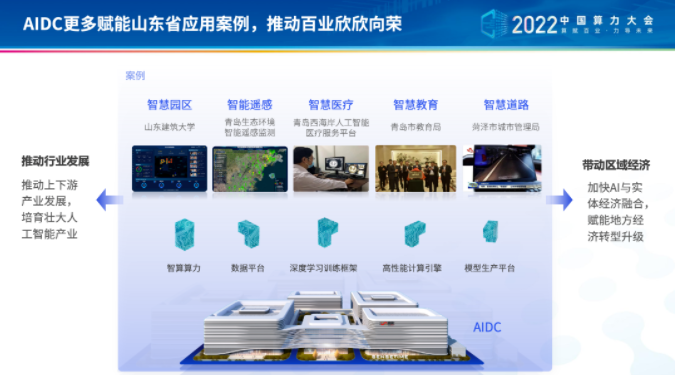
In our opinion, computing power is a very important basic link. In the future, we will continue to build better, newer, and higher-quality infrastructure through technological progress and system improvement, and thus provide more valuable software and application services for the entire industry, production and life, and scientific and technological progress.
Only in this way can the development of computing power and industrial progress form a closed loop and bring sustainable benefits.